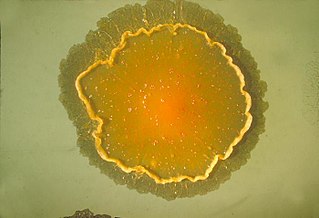
Mycobacterium tuberculosis, also known as Koch's bacillus, is a species of pathogenic bacteria in the family Mycobacteriaceae and the causative agent of tuberculosis. First discovered in 1882 by Robert Koch, M. tuberculosis has an unusual, waxy coating on its cell surface primarily due to the presence of mycolic acid. This coating makes the cells impervious to Gram staining, and as a result, M. tuberculosis can appear weakly Gram-positive. Acid-fast stains such as Ziehl–Neelsen, or fluorescent stains such as auramine are used instead to identify M. tuberculosis with a microscope. The physiology of M. tuberculosis is highly aerobic and requires high levels of oxygen. Primarily a pathogen of the mammalian respiratory system, it infects the lungs. The most frequently used diagnostic methods for tuberculosis are the tuberculin skin test, acid-fast stain, culture, and polymerase chain reaction.

Mycobacterium is a genus of over 190 species in the phylum Actinomycetota, assigned its own family, Mycobacteriaceae. This genus includes pathogens known to cause serious diseases in mammals, including tuberculosis and leprosy in humans. The Greek prefix myco- means 'fungus', alluding to this genus' mold-like colony surfaces. Since this genus has cell walls with Gram-positive and Gram-negative features, acid-fast staining is used to emphasize their resistance to acids, compared to other cell types.
Mycobacterium avium subspecies paratuberculosis (MAP) is an obligate pathogenic bacterium in the genus Mycobacterium. It is often abbreviated M. paratuberculosis or M. avium ssp. paratuberculosis. It is the causative agent of Johne's disease, which affects ruminants such as cattle, and suspected causative agent in human Crohn's disease and rheumatoid arthritis. The type strain is ATCC 19698.

Mycobacterium smegmatis is an acid-fast bacterial species in the phylum Actinomycetota and the genus Mycobacterium. It is 3.0 to 5.0 µm long with a bacillus shape and can be stained by Ziehl–Neelsen method and the auramine-rhodamine fluorescent method. It was first reported in November 1884 by Lustgarten, who found a bacillus with the staining appearance of tubercle bacilli in syphilitic chancres. Subsequent to this, Alvarez and Tavel found organisms similar to that described by Lustgarten also in normal genital secretions (smegma). This organism was later named M. smegmatis.

Mycobacterium marinum is a slow growing mycobacterium (SGM) belonging to the genus Mycobacterium and the phylum Actinobacteria. The strain marinum was first identified by Aronson in 1926 and it is observed as a pathogenic mycobacterium. For example, tuberculosis like infections in fish (mycobacteriosis) and skin lesions in humans.

Mycobacteroides abscessus is a species of rapidly growing, multidrug-resistant, nontuberculous mycobacteria that is a common soil and water contaminant. Although M. abscessus most commonly causes chronic lung infection and skin and soft tissue infection (SSTI), it can also cause infection in almost all human organs, mostly in patients with suppressed immune systems. Amongst NTM species responsible for disease, infection caused by M. abscessus complex are more difficult to treat due to antimicrobial drug resistance.
Mycobacterium boenickei is a member of the Mycobacterium fortuitum third biovariant complex. They are rapidly growing ubiquitous environmental organisms that normally inhabit soil, dust and water. These organisms frequently are human pathogens that cause a wide spectrum of clinically significant disease. It is important for practitioners to be aware of these organisms as possible etiological agents, as they are resistant to most first-line anti-tuberculous agents.
Mycobacterium bohemicum is a species of the phylum Actinomycetota, belonging to the genus Mycobacterium.
Mycobacterium chubuense is a species of the phylum Actinomycetota, belonging to the genus Mycobacterium.
Mycobacterium conceptionense is a non pigmented rapidly growing mycobacterium was first isolated from wound liquid outflow, bone tissue biopsy, and excised skin tissue from a 31-year-old woman who suffered an accidental open right tibia fracture and prolonged stay in a river. Etymology: conceptionense, pertaining to Hôpital de la Conception, the hospital where the first strain was isolated.
Mycobacterium elephantis, a bacterium of the family Mycobacteriaceae, was discovered and isolated from a deceased elephant near India and may be linked to respiratory dysfunction. Organisms in the genus Mycobacterium are known to be aerobic and non-motile. Organisms within Mycobacterium belong to either the rapid growing group or the slow growing group. M. elephantis is classified as a rapid grower and relates most closely to Mycobacterium confluentis and Mycobacterium phlei.
Mycobacterium goodii is an acid-fast bacterial species in the phylum Actinomycetota and the genus Mycobacterium.
Mycobacterium gordonae is a species of Mycobacterium named for Ruth E. Gordon. It is a species of the phylum Actinomycetota, belonging to the genus Mycobacterium.
Mycobacterium avium complex is a group of mycobacteria comprising Mycobacterium intracellulare and Mycobacterium avium that are commonly grouped because they infect humans together; this group, in turn, is part of the group of nontuberculous mycobacteria. These bacteria cause Mycobacterium avium-intracellulare infections or Mycobacterium avium complex infections in humans. These bacteria are common and are found in fresh and salt water, in household dust and in soil. MAC bacteria usually cause infection in those who are immunocompromised or those with severe lung disease.

Mycobacterium kansasii is a bacterium in the Mycobacterium genus. It is an environmental bacteria that causes opportunistic infections in humans, and is the one of the leading mycobacterial causes of human disease after tuberculosis and leprosy.
Mycolicibacter kumamotonensis is a species of bacteria.
Etymology: kumamotonensis, pertaining to Kumamoto Prefecture in Japan, where the type strain was isolated.
Mycobacterium monacense is a yellow-pigmented, non-photochromogenic species of mycobacterium named after Monacum, the Latin name of the German city Munich where the first strain was isolated. It grows in less than a week on solid medium.
Mycobacterium senegalense is a species of Mycobacterium.
Mycobacterium rhodesiae is a species of Mycobacterium.
Mycobacterium tokaiense is a species of Mycobacterium.





